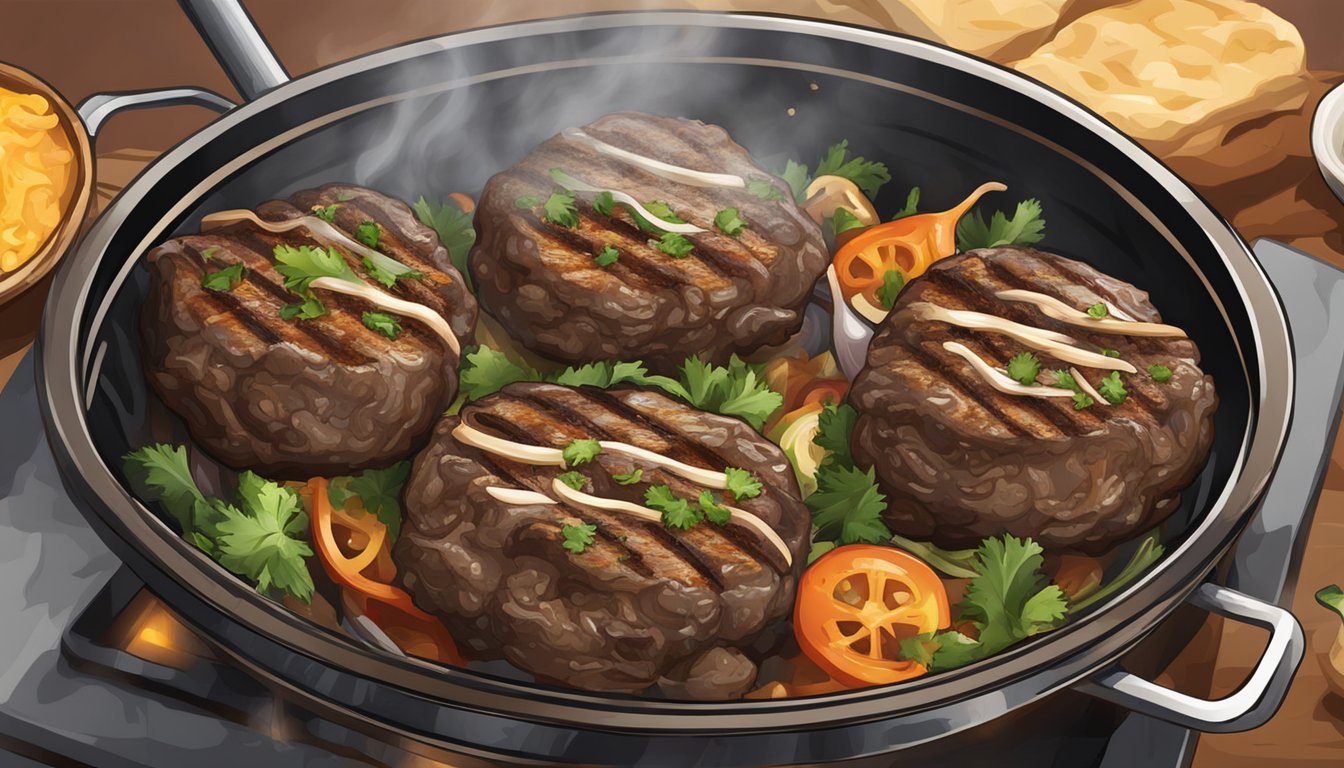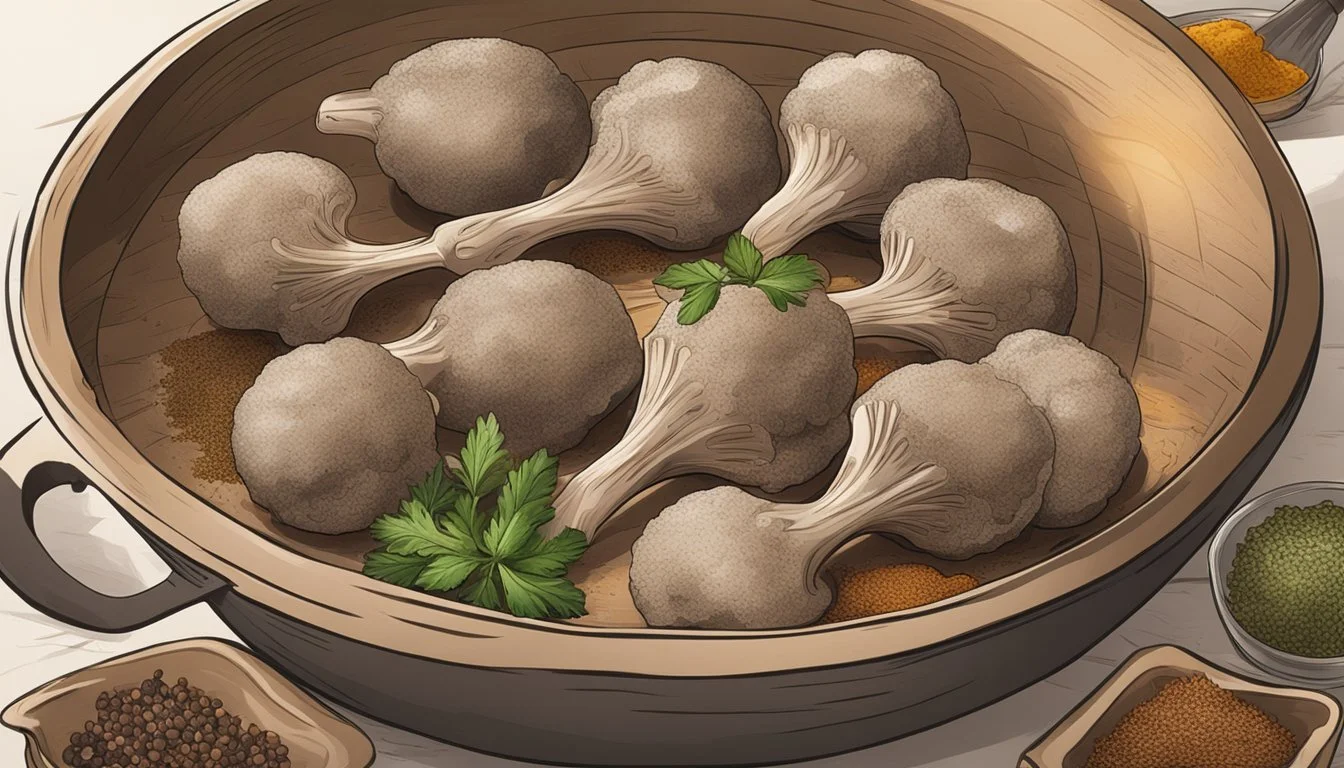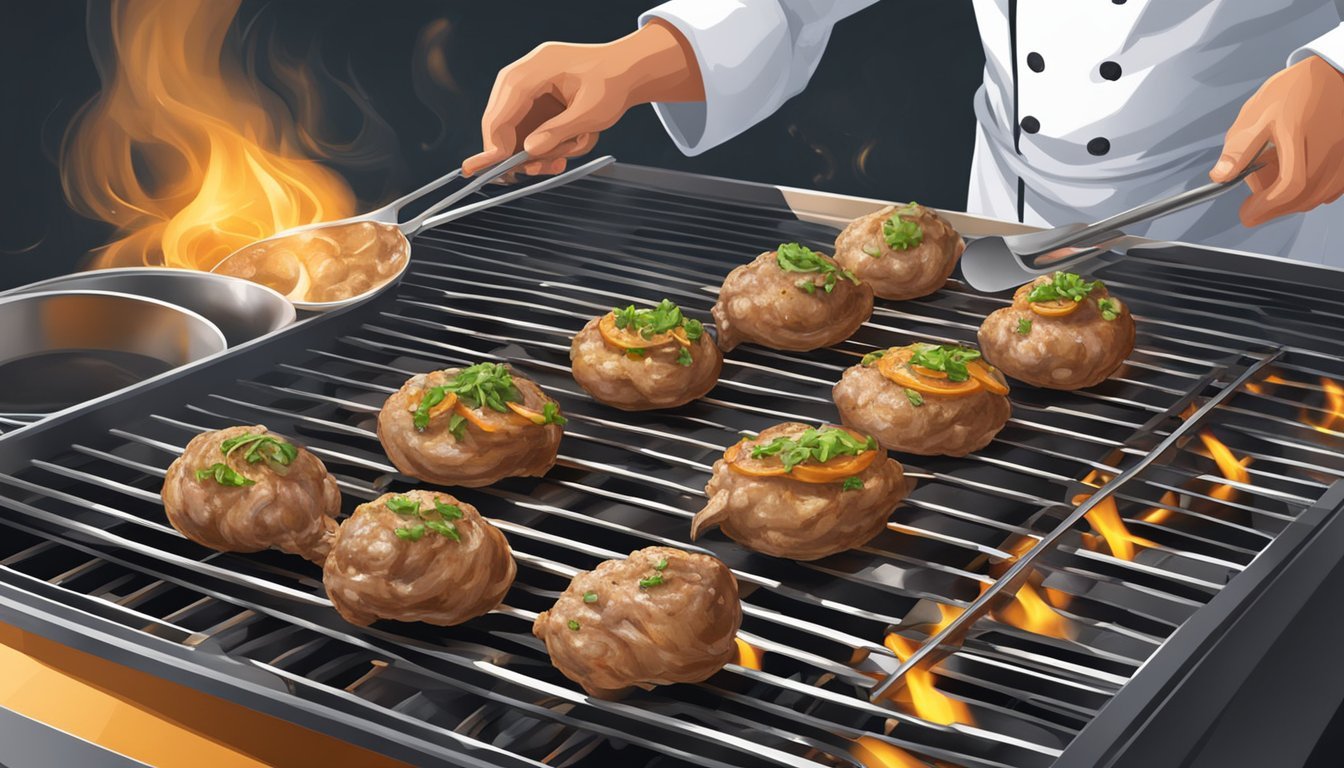Lamb Testicles
Exploring the Savory Tradition of Middle Eastern Kaleji
Lamb testicles, known as kaleji in Middle Eastern cuisine, are a delicacy that reflects the region's rich culinary traditions. They are a part of the broader category of offal, the organ meats of animals that are often overlooked in Western gastronomy but treasured in other parts of the world for their unique flavors and textures. Valued for their tenderness and distinct taste, lamb testicles are enjoyed in a variety of cooking methods, with grilling being among the most popular.
In various Middle Eastern cultures, lamb testicles are prepared with careful attention to detail. The process begins with the meticulous cleaning and removal of the outer membranes, after which the testicles can be seasoned and cooked. Typically, they are either grilled over open flames or pan-fried to achieve a crispy exterior while maintaining a succulent interior.
This specialty dish is often served in social gatherings and special occasions, signifying the importance of communal dining and sharing in these cultures. By incorporating simple yet flavorful seasonings, typically just salt and pepper, the natural flavors of the lamb testicles are enhanced, making them a savory treat for those willing to explore the diverse landscape of Middle Eastern gastronomy.
Historical and Cultural Context
Lamb testicles hold a unique place in culinary traditions, particularly in the Middle East, where their historical and cultural roots run deep.
Cultural Significance
In the Middle East, lamb testicles – also known as "Kaleji" when grilled – are more than just a food item; they carry significant cultural weight. Often associated with festivals, religious holidays, and celebrations, they are a traditional delicacy. For example, during Eid al-Adha, one of the holiest events in Islamic culture, the sacrifice and subsequent consumption of a lamb is a pivotal ritual. This symbolizes devotion and reverence within the community. The preparation and consumption of lamb testicles during such occasions reinforce their cultural impact.
Global Variations
Lamb testicles go by many names worldwide, often as a form of euphemism to make the dish more palatable to the uninitiated. For instance, in North America, they are colloquially termed "Rocky Mountain oysters (What wine goes well with oysters?)". While in parts of Latin America, similar dishes using the testicles of different livestock are prevalent. Each region brings its unique preparation and seasoning methods, from breading and frying to sautéing with local spices. This illustrates the organ’s versatility and the various cultural approaches to incorporating it into cuisine, showcasing its historical and cultural significance across different culinary traditions.
Nutritional Profile
Lamb testicles, also known as lamb fries, are a nutritious delicacy popular in Middle Eastern cuisine. They boast a significant amount of protein, with an estimated 18 grams of protein per serving. Protein is a crucial component for muscle repair and growth, making lamb testicles a good option for individuals requiring high-protein diets.
In terms of vitamins and minerals, lamb testicles provide essential nutrients that play vital roles in the body. They contain iron, which is vital for oxygen transport and energy production within the body. Additionally, these organ meats are sources of zinc, an important mineral for immune function, DNA synthesis, and cell division.
The nutritional content of a typical serving of lamb testicles is summarized below:
Protein: 18g
Fat: Total fats vary, with monounsaturated fats at around 0.6g.
Cholesterol: Approximately 445mg, which is a considerable amount.
Sodium: About 100mg.
Carbohydrates: 0g
Dietary Fiber: 0g
Sugars: 0g
Vitamin D: 0mcg
Calcium: 6.8mg
It's important to note that while lamb testicles are low in carbohydrates, they are high in cholesterol, which should be moderated in consumption, particularly for individuals with cholesterol-related health concerns. As a comparatively niche food item, lamb testicles might not be a staple in most diets but can provide nutritional benefits when prepared properly and consumed in moderation.
Culinary Preparation
Lamb testicles are a unique Middle Eastern delicacy, valued for their tender texture and subtle flavor. This section will guide the reader through the essential ingredients and various techniques used to transform lamb testicles into a savory dish.
Ingredient Overview
Lamb testicles:
Flavor: Subtle, delicate taste
Texture: Known for their tenderness
Additional ingredients:
Salt: Enhances the natural flavor of the meat
Lemon juice: Adds brightness and may also be used in soaking
Herbs: Such as parsley or cilantro, to infuse aroma
Spices: Cumin, coriander, or paprika are traditional choices
Garlic: Used for seasoning, it provides a pungent kick
Oil: Olive oil is commonly used for both marinating and grilling
Breadcrumbs, flour, egg: Often used for breading if frying is chosen as the cooking method
Milk: Sometimes used in soaking the testicles to mellow any strong flavors
Cooking Techniques
Marinating:
Ingredients typically include a mixture of lemon juice, olive oil, minced garlic, and a blend of spices.
Marinating time can range from 30 minutes to several hours, allowing flavors to permeate.
Grilling:
Lamb testicles are often grilled over charcoal to impart smokiness.
The meat should be charred on the outside while maintaining a tender interior, achieved by cooking indirectly over medium heat for 10 to 15 minutes.
Frying:
A common method involves breading with a mixture of flour, egg, and breadcrumbs.
The breaded testicles are then fried in hot oil until golden and crispy, providing a textural contrast.
Blanching and peeling:
Testicles are initially blanched to par cook them and to ease the removal of the outer membrane.
The skin is then incised to peel away, revealing the meat that is ready for further cooking.
Serving and Presentation
When Lamb Testicles, also known as 'Kaleji', are served in Middle Eastern cuisine, presentation varies depending on whether they are offered as an appetizer or a main course. The method of serving enhances the dish's subtle flavors and rich texture.
Suggested Accompaniments
Appetizer:
As an appetizer, Lamb Testicles can be served with a variety of dipping sauces ranging from a simple tahini-based sauce to a more complex harissa for a spicy kick.
A small salad of chopped vegetables or a medley of pickled veggies complements the rich taste.
Main Course:
When presented as a main dish, it pairs well with a side of grilled vegetables, bringing a smoky flavor and freshness to the palate.
Pita bread is a staple accompaniment, perfect for savoring the juices and flavors of the grilled testicles.
Plating Suggestions
Aesthetic garnishing with fresh herbs is important, as it contrasts the grilled texture.
It could be elegantly arranged on a shared platter with sections for sauces and veggies.
Main Course Platter:
For a main course, plating on a larger dish with whole foods such as whole grilled tomatoes or peppers adds color and variety.
The grilled Lamb Testicles should be the centerpiece with other elements artfully arranged around it.
Sustainability and Ethical Considerations
In the context of Middle Eastern culinary practices, the use of lamb testicles, also referred to as 'Kaleji', represents a sustainability-conscious approach. This method aligns with the ethos of using the whole animal to minimize waste. Lamb testicles are byproducts of the castration process, and utilizing them appreciates the value of the entire animal, reducing the environmental impact associated with discarding edible parts.
Grass-fed lamb is often touted for its superior quality both in terms of animal welfare and ecological benefits. Grass-fed systems generally lead to less soil erosion and better water retention, creating a more sustainable environment for raising livestock.
Organic practices further enhance sustainability by avoiding the use of synthetic pesticides and fertilizers, leading to a reduction in environmental contamination. The pasture-raised process, central to many organic farms, allows for a natural diet and reduced stress for the animals, thereby contributing to ethical considerations.
Preservation methods, such as the use of a freezer, facilitate the extended availability of lamb testicles. Freezing these byproducts allows them to be offered throughout the year, rather than only seasonally. By doing so, suppliers can ensure a consistent and sustainable demand, supporting farmers and reducing potential waste.
Lastly, by considering lamb testicles as a valuable resource rather than a discardable byproduct, these traditions and practices advocate a holistic view of animal husbandry. This approach respects the life of the lamb and encourages a more ethical and environmentally mindful perspective on food consumption.
Purchasing and Storage
When seeking to purchase lamb testicles, one may find them at butcher shops that offer a broad range of meats, including unconventional cuts and offal. In the United States, they are not as commonly found in mainstream supermarkets but can be sourced from specialty meat providers or international markets, particularly those which cater to Middle Eastern cuisines.
Purchasing Tips:
Freshness: Look for testicles that are firm to the touch and have a fresh, clean smell.
Appearance: The color should be uniform, leaning towards a pale pink hue, without any discoloration.
Sourcing: Opt for testicles from a reputable butcher to ensure the animals were raised and processed humanely.
Once acquired, storage is critical to maintain the integrity of the meat.
Temperature: Cold, Storage Method: Refrigeration, Duration: 1-2 days
Temperature: Very Cold, Storage Method: Freezer, Duration: Up to a month
For refrigeration:
Store them in a sealed container or wrap them tightly in plastic to prevent cross-contamination and absorbing odors.
Place them in the coldest part of the refrigerator.
For freezing:
Wrap each testicle individually in plastic wrap, followed by aluminum foil, or use a vacuum sealer.
Label each package with the date of freezing to keep track of freshness.
Thaw frozen testicles in the refrigerator overnight when ready to use, not at room temperature.
Consumers should handle lamb testicles just as they would handle other types of fresh meat, with careful attention to cleanliness and temperature control.
Preparation Safety
When preparing lamb testicles, or 'kaleji,' it is essential to handle them with care to avoid potential health risks. Initial Cleaning is crucial and involves the removal of the outer membrane, which can harbor bacteria. Chefs should wear gloves and use a sharp knife to gently trim the ends and then peel back this membrane, disposing of it immediately to maintain hygiene.
Blanching is a recommended step. This process partially cooks the testicles, ensuring that the interior reaches a safe temperature during grilling. One should blanch them in boiling water for a few minutes and then immerse in ice water to stop the cooking process. This makes the removal of any remaining membrane easier while also reducing pathogens.
Cross-contamination is a concern in any kitchen. It's imperative to use separate utensils and cutting boards for testicles and other ingredients, especially those that are eaten raw. After handling testicles, chef’s tools and surfaces should be thoroughly cleaned with hot, soapy water.
Below is a checklist for safe preparation:
Initial Cleaning:
Remove outer membrane
Trim ends carefully with clean tools
Blanching:
Boil in water for several minutes
Cool immediately in ice water
Preventing Cross-Contamination:
Use separate utensils and cutting boards
Clean all surfaces after preparation
If the recipe calls for an egg wash as a binding agent for breadcrumbs, one must ensure that the eggs are fresh to minimize the risk of salmonella. Eggs should be cracked into a clean, separate container and beaten thoroughly before any testicle slices are dipped into them.
Adhering to these safety measures ensures that the experience of enjoying grilled lamb testicles is not only flavorful but also safe.
Cooking Variations and Techniques
Lamb testicles, known in Middle Eastern cuisine as "Kaleji," offer a taste experience that varies significantly depending on the cooking method. These culinary variations highlight the versatility of lamb fries, each technique bringing out different textures and flavors, from juicy and tender to a crisply breaded exterior.
Grilled Kaleji
Grilling lamb testicles, especially over charcoal, imparts a smoky flavor that complements the meat's natural taste. The process typically involves salting and peppering the lamb fries and placing them on the grill to cook indirectly. The aim is to achieve a nicely charred outer surface while keeping the inside tender, usually taking about 10 to 15 minutes.
Pan-Fried and Sautéed
Pan-frying or sautéing allows for a more controlled cooking environment, which can result in an evenly cooked lamb testicle with a golden-brown exterior. The lamb fries can be lightly breaded or seasoned before being pan-fried or sautéed in oil, ensuring they are turned occasionally to cook through without burning.
Deep-Fried
For a crunchy texture, deep-frying lamb testicles transforms them into the sought-after delicacy occasionally referred to as "Rocky Mountain oysters." Dipped in a seasoned batter, the lamb fries are submerged in hot oil until they achieve a golden, crispy crust. The result is a juicy interior enveloped by a crunchy shell, making them a unique and popular variation.
Recipe Ideas and Inspiration
Lamb testicles, also known as "kaleji" in Middle Eastern cuisine, offer a plenitude of recipe options for the adventurous palate. Chefs appreciate their unique texture and flavor, often highlighted through grilling, a technique that imparts a smoky char.
Grilling: For those seeking a rustic approach, grilling lamb testicles is straightforward. After cleaning, they season the meat with salt, pepper, and perhaps a hint of cardamom for an aromatic touch. They grill the testicles indirectly to avoid overcooking, aiming for a nicely charred exterior.
Marinades: A marinade infuses the testicles with deeper flavors. Ingredients such as olive oil, citrus juices, garlic, and spices, including cardamom, are commonly used. The testicles are submerged in the marinade before being skewered and grilled until tender.
Fried Testicles:
Blanch and peel the testicles first.
Cut into thin slices or wedges.
Dip in beaten egg and then in seasoned panko crumbs.
Fry in oil until they achieve a golden-brown crust.
For those preferring a robust entree, testicles can be cooked similarly to a steak. Sautéing or pan-frying with a simple seasoning allows the meat's flavor to shine. Chefs may opt for a quick sear on high heat to form a savory crust while keeping the interior tender.
Lastly, serving lamb testicles is often a visual and flavorful experience. Garnishes like lemon wedges, fresh herbs, or a sprinkle of sumac add vibrancy and zest. Whether grilled or fried, they are customarily accompanied by a selection of sides such as fresh vegetables, bread, and dips.
Glossary of Terms
Offal: The collective term for the organs and entrails of a butchered animal. Offal includes a variety of organs, often considered to be a delicacy in many cultures, and it is a key component in numerous traditional recipes.
Lamb Sweetbreads: A highly prized variety of offal that represents the thymus gland and pancreas. These are not to be confused with lamb testicles, although sweetbreads share the term's etymology of "sweet" and "bread" due to their flavor and texture.
Lamb Stones: Another name for lamb testicles, which are used as food. The term is less common but can be found in historical and regional culinary discussions.
Goat Testicles: Similar to lamb testicles in their culinary use, these are the testes of a goat, also enjoyed in several cuisines, especially in Middle Eastern dishes, and they can be prepared in various ways.
Testes: The scientific term for the male reproductive glands that produce sperm. In the culinary world, testes from lamb and goat are known as lamb fries or animelles when prepared as food.
Glands: Organs that secrete particular chemical substances for use in the body or for discharge into the surroundings. In cooking, glands like sweetbreads are utilized for their unique texture and flavor.
Batter: A mixture of flour, eggs, and milk or water that is used as a coating for food items that are to be fried. Lamb testicles are often coated in batter and fried, resulting in a crispy exterior.
Criadillas: A Spanish term for bull testicles, it also refers to the testicles of other animals and is a common term used in Spanish-speaking countries for this type of offal.
Animelles: A French culinary term that refers to the testicles of an animal, considered a gourmet delicacy. The term can be applied to both lamb and goat testicles.
Prairie Oysters: A North American term that broadly includes the testicles of any animal, often battered and deep-fried. It does not actually involve oysters from the sea but received the name due to the texture's slight similarity to oysters.








